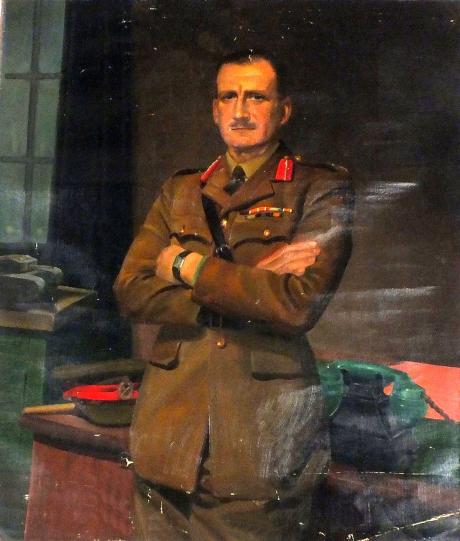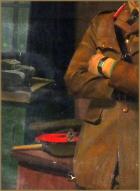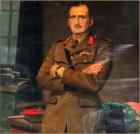By descent from the artists studio Cornwall
Major General Sir Eric Bertram Rowcroft KBE CB MIMechE MIEE (28 January 1891 – 27 December 1963), was a British Army officer. His military career started in 1908 as a TA Officer in the Royal Engineers and retired at the rank of Major General in 1946. He is noted for his involvement in the formation of The Corps of Royal Electrical and Mechanical Engineers (REME) and the planning of Operation Overlord.
EB Rowcroft was born at West Kensington London England on 28 Jan 1891 to Col George Francis Rowcroft (1861-1953) and Florence Marion Eva Rowcroft ( nee Hennessy) (1859-1943). He died 21 Dec 1963 at Lyme Regis West Dorset England.
Educated at Haileybury and the Regent Street Polytechnic, Sir Bertram first joined the Territorial Army in 1908. A year later he decided to take up a military career and, after passing into the Royal Military College, Sandhurst, he was gazetted to the Army Service Corps in 1911. After his initial involvement with the TA, Rowcroft received his commission in 1911 after he passed out of Sandhurst into the Army Service Corps. At the outbreak of The First World War he served with the BEF overseas serving with various mechanical transport units. By 1918, Rowcroft worked at the War Office in a technical capacity. During the interwar period he served in India, Ceylon and even at the Tank Inspection Department, at Woolwich Arsenal. His Army Career continued along the Technical route when in 1936 he was appointed Commander Royal Army Service Corps (RASC), 1st Div in Palestine.
His outstanding work with the Supply and Transport Directorate during the early part of the 1939-45 war made him the natural choice when a man of high organizational and technical ability was needed to guide the formation of a new technical Corps; REME. His consummate skill and great energy proved equal to the task and he not only brought the Corps into being but also made long-term plans for its role in peace. He retired in 1946 though he was able to retain his association with the Corps as Colonel Commandant from that year until 1956.
Sir Bertram became an Associate Member of this Institution in 1925 and transferred to Member in 1942. He delivered a James Clayton Lecture in 1947. With all his brilliance and efficiency he was nevertheless a very human and charming person and he will be much missed by his many friends in all walks of life.
In 1942 the Mechanical Engineering Directorate at the War Office was established under the Director of Mechanical Engineering (DME), Major-General E B Rowcroft (later Sir Bertram Rowcroft). A plan for the subsequent development of the Corps was drawn up in three stages of nine months each, and in almost every detail planned target dates were achieved. In India the IEME was formed, which was separate from REME since at this time the Indian Army was a separate organisation although many officers and technical personnel were British. HQ REME Training Establishment was formed at Arborfield to control REME technical training. The repair system in the field was reorganised so that repair could be carried out as far forward as possible. The take-over from RAOC of responsibility for scaling of spares was completed. DMEs and deputies were appointed to all major headquarters of the field army and deputy directors were appointed to all static command headquarters. Commanders REME were appointed to divisions and Brigade EMEs to brigades.
In 1942 the Mechanical Engineering Directorate at the War Office was established under the Director of Mechanical Engineering (DME), Major-General E B Rowcroft (later Sir Bertram Rowcroft). A plan for the subsequent development of the Corps was drawn up in three stages of nine months each and in almost every detail planned target dates were achieved. In India the Indian EME (IEME) was formed, which was separate from REME since, at this time, the Indian Army was a separate organisation although many officers and technical personnel were British. Also, HQ REME Training Establishment was formed at Arborfield, Berkshire to control REME technical training. Importantly, the repair system in the field was reorganised so that repair could be carried out as far forward as possible and the take-over from RAOC of responsibility for scaling of spares was completed. DMEs and deputies were appointed to all major headquarters of the field army and deputy directors were appointed to all static command headquarters. Commanders REME (CREME) were appointed to divisions and Brigade Electrical and Mechanical Engineers (BEME) to brigades.
Almost at once the new organisation was tried out and proved successful at the 2nd Battle of Alamein; the first major operation after the Corps was formed. The re-organised recovery and repair system was thoroughly tested during the remainder of the war, during which REME grew to be the largest technical corps, extending its activities to include the manufacture of spare parts and special equipment on a large scale. In addition to its uniformed tradesmen, the Corps employed thousands of civilian tradesmen of many different nationalities in its static workshops throughout the world.
REME reached its maximum strength in May 1945, approximately 8000 officers and 152,000 other ranks. The IEME, East and West African EMEs, Royal Canadian, Australian, New Zealand EMEs, and the South African Technical Service Corps (TSC) totalled another 185,000. Some 130,000 civilians were employed in EME Services in all parts of the world.
For his efforts during the Second World War Rowcroft was appointed a Companion of the Order of the Bath (CB) in 1944,[3] and in 1946 on his retirement from the Army he became a Knight of the Order of the British Empire (KBE).However, his involvement in the REME continued until 1956, as he served in the capacity of Colonel Commandant. During his later years he got heavily involved in local affairs in his home town of Lyme Regis, where he died in 1963.
Born in Montreal, Canada, Haylett moved with his parents back to Britain at the age of two and was brought up in Southend-on-Sea. He studied art there and at St Martins, London. A recent correspondent (2016) writes that she owns a portrait by Haylett which the artist painted of her father during the war (1944) while they were posted to India. He was primarily a portrait painter although he had a broad range of art and design skills, and was invited to St Ives shortly after the War by his friend the photographer Gilbert ADAMS.
He was so taken by the ambience of the town that he took a studio in Westcott's Quay on the spot. His fiancée Jean, a fashion student, joined him and they married in 1946. His favourite portrait subject was his wife, although he soon began to win commissions from the rich and famous. He was asked by one of the organisers of the Daily Mail Ideal Home Exhibition to submit a design. His scheme was selected for the 1954 Exhibition and was such a success he was given the accolade of being selected the following year as well.
He also redesigned a number of shops in St Ives, was a design consultant for Plymouth Breweries, and designs for two of his homes were featured in Ideal Homes. Haylett also taught art at Redruth School of Art, the St Ives School of Painting and Camborne College.
In August 2011 an auctioneer selling one of his paintings came across a businesss card giving Haylett's address in 1950 as 'The Warren, St Ives'.
media
Painter of portraits; designer and teacher
works and access
Works include: Portraits Lady Marguerite Tangye; Duke of Beaufort;Cardinal Heenan; Patrick Lichfield; Sir Russell Brock; Sir Geoffrey Jefferson, and child portraits of Jonathan and Hayley Mills (children of actor Sir John Mills)
The Return to Plymouth of Sir Francis Chichester was commissioned by the Royal Yacht Club, Falmouth
Locally: Portrait of Robert Lyle (c1928-c2002) Former High Sheriff of Cornwall 1984-5 (1985) at Helston Folk Museum
exhibitions
STISA (first show) 1947, 1951 Festival of Britain Touring Show
Downing's Bookshop One-man show 1948
DMIHE 1954 and 55



